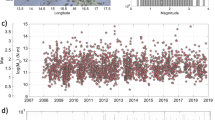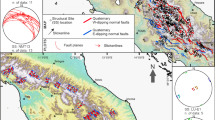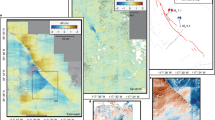Abstract
SLIP movements along active faults may either occur violently, and generate earthquakes, or gradually in a little understood process called fault creep1–5. An interesting feature of fault creep is that it is frequently episodic rather than continuous and the episodes of movement propagate along the fault1. The mathematics, but not the physics, of the process are identical to those of crystal dislocations6.
This is a preview of subscription content, access via your institution
Access options
Subscribe to this journal
Receive 51 print issues and online access
$199.00 per year
only $3.90 per issue
Buy this article
- Purchase on Springer Link
- Instant access to full article PDF
Prices may be subject to local taxes which are calculated during checkout
Similar content being viewed by others
References
King, C. Y., Nason, R. D., and Tocher, D., Phil. Trans. R. Soc., A 274, 355 (1973).
Burford, R. O., Allen, S. S., Lamson, R. J., and Goodreau, D. D., in Tectonic Problems of the San Andreas Fault System, Publ. geol. Sci., 13, 268–274 (Stanford University, California, 1973).
Nason, R. D., and Weertman, J., J. geophys. Res., 78 (32) 7745 (1973).
Nason, R. D., Philippsborn, F. R., and Yamashita, R. A., Catalogue of Creep-meter Measurements in Central California from 1968 to 1972 (United States Geological Survey, National Centre for Earthquake Research, Menlo Park, California, 1974).
Yamashita, R. A., and Burford, R. O., Catalogue of Preliminary Results from an 18-station creepmeter network along the San Andreas fault system in Central California for the time interval June 1969–June 1973 (United States Geological Survey, National Centre for Earthquake Research, Menlo Park, California, 1974).
Nabarro, F. R. N., Theory of Crystal Dislocations (Oxford University Press, London, 1967).
Frank, F. C., Phil. Trans. R. Soc., A 274, 351 (1973).
Tchalenko, J. S., and Ambraseys, N. N., Bull. geol. Soc. Am., 81, 41 (1970).
Bilham, R. G., King, G. C. P., and McKenzie, D. P., Geophys. J. R. astr. Soc., 37, 237 (1974).
Stewart, R. M., Bufe, C. G., and Pfluke, J. H., in Tectonics Problems of the San Andreas fault system, Publ. geol. Sci. 13, 286–293 (Stanford University California, 1973).
Author information
Authors and Affiliations
Rights and permissions
About this article
Cite this article
KING, G., BILHAM, R., CAMPBELL, J. et al. Detection of elastic strainfields caused by fault creep events in Iran. Nature 253, 420–423 (1975). https://doi.org/10.1038/253420a0
Received:
Revised:
Issue Date:
DOI: https://doi.org/10.1038/253420a0
This article is cited by
-
Slow earthquakes and stress redistribution
Nature (1978)
-
Bimodal distribution of creep event amplitudes on the San Andreas fault, California
Nature (1977)
-
Strainmeter technology (reply)
Nature (1975)
-
Wire strainmeters on ice
Nature (1975)
-
Strainmeter technology
Nature (1975)
Comments
By submitting a comment you agree to abide by our Terms and Community Guidelines. If you find something abusive or that does not comply with our terms or guidelines please flag it as inappropriate.



